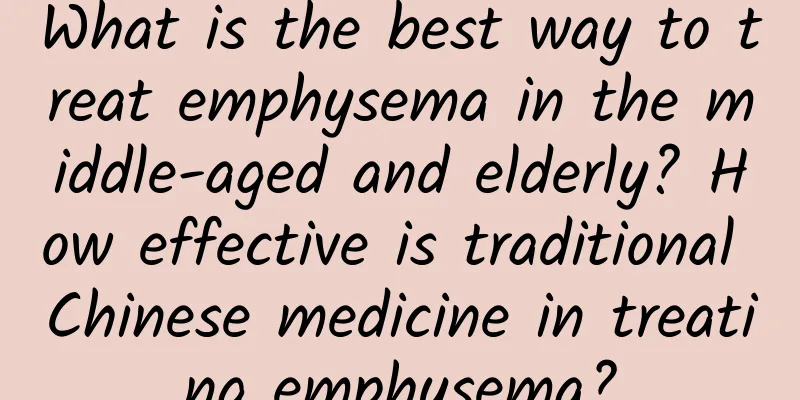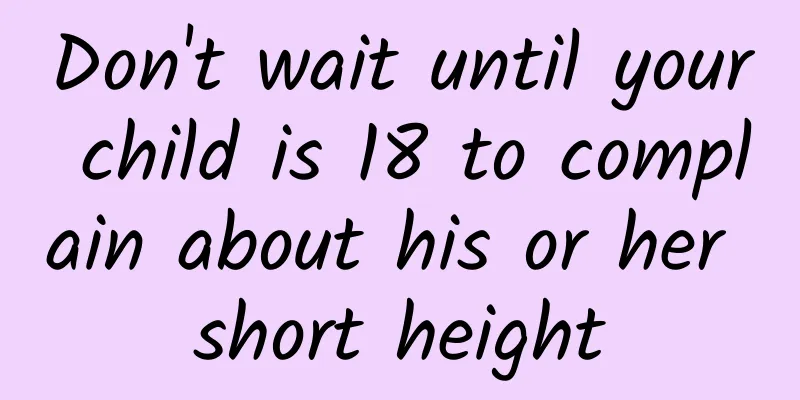What is the best way to treat emphysema in the middle-aged and elderly? How effective is traditional Chinese medicine in treating emphysema?

|
Author: Chen Zhenchong Unit: Department of Traditional Chinese Medicine, Dagang Town Community Health Service Center, Nansha District, Guangzhou Emphysema, also known as chronic obstructive pulmonary disease, is a common chronic respiratory disease characterized by airway restriction and ventilation obstruction, leading to breathing difficulties. Emphysema mainly includes two diseases, chronic bronchitis and emphysema, which are usually related to long-term smoking, environmental pollution and genetic factors. The incidence of this disease is increasing year by year, especially among middle-aged and elderly people. 1. Western medicine treatment of emphysema Western medical treatment includes medication, physical therapy and surgical intervention, providing a variety of options for different degrees and characteristics of the disease. 1. Medication Bronchodilators: Bronchodilators are a key part of emphysema treatment. They improve ventilation by dilating the bronchi, relieving airway spasm, and increasing airflow. Anti-inflammatory drugs: Anti-inflammatory drugs are used to reduce respiratory inflammation, reduce airway spasm and swelling of the respiratory mucosa, help improve lung function and relieve breathing difficulties. Oxygen therapy: Oxygen therapy is a key treatment method, especially for patients with severe emphysema. It provides oxygen through nasal cannula or mask, which helps to increase the partial pressure of oxygen in the blood, relieve symptoms of hypoxia, and improve physical strength and quality of life. 2. Respiratory rehabilitation and lung function training Respiratory rehabilitation is a physical therapy method designed to teach lung disease patients proper breathing techniques to help them use their lungs more efficiently. Rehabilitation classes often include breathing exercises and spirometry exercises to increase the strength and endurance of the respiratory muscles. Pulmonary function training is done through aerobic exercise, such as walking and swimming, to improve lung function and cardiorespiratory endurance. 3. Surgical Intervention Lung lift: Lung lift is a surgical procedure that removes damaged lung tissue, relieves pressure in the lungs, and improves ventilation and oxygenation, and is usually performed in severe cases of emphysema. Lung transplant: Lung transplant is a very extreme treatment option for extremely severe cases of emphysema where the entire lung needs to be replaced. It is a complex and risky surgery that is usually only considered when there are no other treatment options. 4. Vaccination People with emphysema are more susceptible to respiratory infections; getting flu and pneumonia vaccines can reduce the risk of infection and lessen the likelihood of worsening of the disease. 2. TCM treatment of emphysema As an important part of emphysema treatment, TCM emphasizes comprehensive treatment. It can not only alleviate symptoms, but also improve lung function and the quality of life of patients, enabling them to better manage and adapt to chronic lung diseases. 1. TCM syndrome differentiation and treatment TCM syndrome differentiation and treatment is based on the principle of TCM syndrome differentiation and treatment, and the treatment plan is determined according to the patient's symptoms and physical characteristics. Qi deficiency syndrome: For patients with weak lung qi, Chinese medicine may use methods to replenish qi and benefit the lungs, including Chinese medicine and acupuncture therapy, to strengthen the function of lung qi. Phlegm-dampness syndrome: Patients with phlegm-dampness type emphysema usually have excessive phlegm and cough. Traditional Chinese medicine treatment focuses on removing phlegm and dampness, using medication and diet therapy. Obstructive syndrome: Patients with obstructive syndrome may experience airway obstruction. The goal of TCM treatment is to relax the airways and relieve symptoms, which usually includes the use of herbal medicine and acupuncture. 2. Traditional Chinese medicine treatment Traditional Chinese medicine treatments for emphysema often include herbal medicines, usually Chinese medicine formulas, which are formulated based on the patient's syndrome differentiation and treatment. Qi-tonifying drugs: including Chinese herbal medicines such as ginseng and astragalus, which are used to strengthen the patient's lung qi and improve lung function. Expectorants: For patients with phlegm-dampness syndrome, Chinese medicine may include drugs such as Perilla frutescens and Pinellia ternata to help clear phlegm. Heat-clearing and detoxifying drugs: In some cases, if emphysema is accompanied by infection, Chinese medicine can use heat-clearing and detoxifying drugs, such as honeysuckle, forsythia, etc. 3. Acupuncture Acupuncture is an important part of traditional Chinese medicine and can be used to treat emphysema. Acupuncture stimulates specific acupuncture points to help promote airflow, improve lung function, and relieve breathing difficulties. Usually, a traditional Chinese medicine practitioner will select the appropriate acupuncture points and acupuncture techniques based on the patient's syndrome differentiation. 4. Tuina massage therapy Tui Na massage therapy is a traditional Chinese medicine treatment method that uses massage, manipulation, and gentle stretching to promote airflow and relieve tension and pain. For people with emphysema, specific massage and manipulation techniques can be used to relax respiratory muscles, promote deep breathing, and reduce tension. The effectiveness of combined TCM treatment of emphysema often varies from person to person, but in some cases, TCM syndrome differentiation and treatment and herbal therapy can play a positive role in comprehensive treatment, thereby improving the patient's quality of life. 3. The Importance of Comprehensive Treatment of Chinese and Western Medicine Emphysema in the middle-aged and elderly is a chronic disease that usually requires long-term management and treatment. The importance of integrated Chinese and Western medicine treatment lies in the ability to comprehensively utilize the advantages of the two medical systems to maximize the improvement of the patient's quality of life. 1. Complexity of etiology The causes and symptoms of emphysema are complex and varied. Western medicine mainly focuses on drug therapy, physical therapy and surgical intervention to provide effective control and management for airway inflammation, airway spasm and decreased lung function. Traditional Chinese medicine focuses on individual constitution and syndrome differentiation and treatment, and can provide more personalized treatment methods, especially in regulating the overall health of patients. 2. Symptom relief Middle-aged and elderly patients with emphysema often experience symptoms such as dyspnea, cough, and sore throat, which seriously affect their quality of life. Comprehensive treatment can quickly relieve acute symptoms through Western medicine medication, while using traditional Chinese medicine to deeply understand the cause and alleviate chronic symptoms. 3. Prevent complications Patients with emphysema are prone to other diseases, such as lung infection and cardiovascular disease. Comprehensive treatment can reduce the risk of infection through vaccination with Western medicine, and improve immunity and reduce the occurrence of complications through conditioning with traditional Chinese medicine. 4. Improved quality of life Emphysema is a chronic disease, and comprehensive treatment can help patients better manage their disease and improve their physical strength, breathing ability, and emotional well-being. By collaborating with Chinese and Western medicine, patients can more fully understand and manage their disease, thereby improving their quality of life. On the road to emphysema treatment, Chinese medicine, as an important component, provides strong support for patients. However, emphysema is a complex chronic disease, and no single treatment method can completely solve all problems. Comprehensive treatment can maximize the advantages of Chinese and Western medicine, provide personalized treatment plans, improve symptoms, reduce complications, and improve the quality of life of patients. |
<<: Mycoplasma pneumonia, why are there so many cases suddenly?
>>: What role does EEG play in the field of epilepsy?
Recommend
Is radiation in daily life harmful to the human body?
Radiation is always a concern. But in fact, it is...
Postoperative care for endometrial polyps
Many female friends may not know the symptoms and...
Typhoid Mary: One hundred years ago, she made humans realize for the first time that there are "asymptomatic infections"
Introduction In February 1915[1], the weather in ...
It is taboo to lie down during menstruation
Menstruation is a special period for women, and t...
What to do if your vaginal discharge is brown during early pregnancy
A woman's body undergoes great changes during...
What to do if you have kidney stone pain during pregnancy
In our lives, many people suffer from kidney ston...
Women's ovulation period picture
Women's physiological structure is very uniqu...
Nielsen: In May 2011, 40% of mobile phones in the U.S. were smartphones, 40% of which used Android
According to a recent Nielsen survey, Android sma...
Eating fermented rice wine during breastfeeding makes the baby stupid
Mothers should pay attention to their diet during...
Some people are alive, but their butts are already "dead"...
Work, work, I sit when I go to work, sit all day,...
Suddenly you can’t smell the aroma of food? It could be the coronavirus
Does the loss of smell mean that you are infected...
Not recommended for children! State Food and Drug Administration urgently reminds
The website of the State Food and Drug Administra...
I can’t bear to throw away expired food, but can I still eat it?
I found out that the food I wanted to eat has exp...
Is the liquid dark area dangerous for pregnant women?
Sometimes liquid shadows will appear in the B-ult...
Are Gallstones Risky During Pregnancy?
Recently, some women wanted to get pregnant to we...









